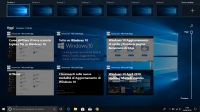 Multiple desktops have been around operating systems for a very long time, but they came to Windows 10 in an easy-to-use feature. I’ve come to really enjoy them and thought I would share how I use the feature in my daily work because I have found that most people don’t know about it.
Multiple desktops have been around operating systems for a very long time, but they came to Windows 10 in an easy-to-use feature. I’ve come to really enjoy them and thought I would share how I use the feature in my daily work because I have found that most people don’t know about it.
First off, what are multiple desktops? If you’re reading on your computer right now, you might have a collection of windows open. That’s a single desktop. Now imagine if you could switch to a new desktop and have a completely different set of windows open while still making it easy to get back to the old desktop. That’s multiple desktops.
There are plenty of tutorials online showing how to set it up and move windows between desktops so I’ll skip that part. The key thing for me is that multiple desktops help me context switch and focus at work. Desktop 1 is for email, IM, Spotify and other communication/peripheral stuff. Then I have a desktop for each task that I’m working on. Since I try to keep multi-tasking to a minimum, this means that ideally I only have one other desktop. Working on this other desktop helps me to stay focused on that activity and not get distracted by email, etc. If someone comes to ask me a question, I can flip to a new desktop, open windows to answer their question and then quickly jump back into the work I was doing.
It’s not a perfect solution though. Some apps don’t play nicely with multiple desktops. OneNote is probably the worst offender in my daily workflow. If I already have OneNote open on Desktop 1 and then I try to open it on Desktop 2, it flips me back to Desktop 1 and opens a second copy. Then I have to drag the window to Desktop 2. It’s annoying but not a deal-breaker.
It’s an advanced feature that takes a while to get used to, but consider giving it a try for a week or two to see if it fits your workflow.
P.S. One usage tip: To quickly flip back and forth once you have multiple desktops going, hold down CTRL+WINDOWS and press the left and right arrows.
